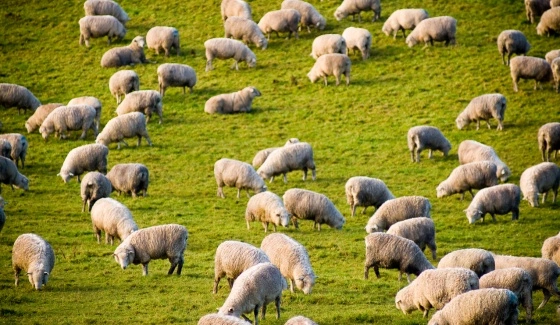
Foot disease in Merinos
Published in P/GK Progression 2024.
The health of sheep feet continues to be an issue in the Australian sheep industry, especially in high rainfall zones and in wet years. Ovine footrot remains the most significant foot problem despite significant investments to eradicate the disease. Footrot is a complex disease caused by infection with the bacteria Dichelobacter nodosus. Bacterial strains range from benign, causing mild disease, to virulent, causing severe disease. The cost of eradication of virulent footrot exceeds $10/sheep.Indirect costs can exceed the direct costs of the disease with management distracted by the need to reduce stocking rates or delay other critical management events resulting in increased animal health problems such as worms or flystrike. Overall, footrot has been estimated to cost the Australian sheep industry $82.3M per year, with $61.0 M associated with production losses.
Ovine interdigital dermatitis (OID; a.k.a. scald),shelly hoof, over-grown hooves and poor pastern angle also cause significant lameness and pain to sheep on farms. These lame sheep tend to have poorer condition scores, slower growth rates, lower fertility and lower general productivity. Foot problems in pregnant ewes can be a significant cause of metabolic diseases and poorer lamb survival. Foot abscesses alone are estimated to cost the Australian sheep industry $10.4M per annum, however this cost varies widely and could be three times higher in very wet years. There is therefore great potential to improve the productivity and welfare of sheep in the medium to high rainfall zones of Australia by reducing the susceptibility of sheep to foot ailments.
It is now clear that the sheep industry must focus on ways to farm with footrot given that eradication is not a viable option. Susceptibility to footrot has shown to be heritable and the New Zealand sheep industry has successfully developed a breeding value for footrot that can be used to reliably reduce the susceptibility of sheep to the disease. A recent project funded by Animal Health Australia has demonstrated that similar genetic variation exists in Australia and the data will contribute towards generation of a breeding value for footrot for Australian Merino breeders.

Breeding value for footrot
Multiple genes contribute to the susceptibility to footrot which means that there is no silver bullet against the disease. This means that we must take a quantitative approach to identify animals that are less susceptible to footrot. Assessment of footrot involves inspecting and individually scoring each foot. Scoring is on a scale of 0 to 5, with 0 being a perfect foot and 5 being the most severe disease. A key feature of virulent footrot is underrunning, which is only seen in score 3-5 footrot. The figure above shows data from a few years ago for the footrot research breeding value for Merinos in New Zealand. Breeding values are set as 0 when they begin, with 0 representing the average of the population for the trait at commencement of the breeding value. Hence, most of the data in this graph sits around 0 (represented by the grey bell curve) and where about half of the population had score 3-5 footrot (shown by the green shading). We are aiming for animals to have breeding values in the negative range because a lower score for footrot means less severe or no disease. Based on the New Zealand data, when we shift to a breeding value of -1, meaning those animals have footrot that is 1 scoreless than the average of the population, only around 15% of the population will have some under running (score 3 footrot) and none of the population will have score 4-5 footrot. Importantly, these figures represent the footrot severity under significant footrot pressure. If we compare this to the outcome under these conditions with the average Merino in the NZ work, the average Merino population would have nearly 50% of animals with at least score 3 lesions and nearly 20% with severe footrot (score 4 and 5). This demonstrates how utilising the footrot breeding value can significantly reduce the severity of footrot in the population and the number of animals present in the flock that are harbouring and spreading the disease to other animals on the property.
New research into the genetics of foot health in Australian Merinos
The Australian sheep industry has a different scenario than New Zealand because of the different laws associated with footrot. It is not possible for stud breeders in Australia to have footrot on their property and still trade rams unlike in New Zealand. This means that in Australia we need designated research sites at locations suitable for a footrot challenge for stud breeders to expose their genetics to footrot and thus enable them to make genetic gains with footrot without having footrot on their property. Other indicator traits such as foot shape and susceptibility to OID may also be useful in helping stud breeders make genetic gains in disease susceptibility.
The “Genetics of foot health in Merinos” project is investigating the genetic variation in footrot, OID and foot abscess along with the genetic and phenotypic correlations between foot health and structural foot traits. It aims to inform the Merino industry on appropriate selection strategies to improve foot health. The project is funded by Australian Wool Innovation, Animal Health Australia and collaborating Merino breeders and is being conducted by Murdoch University and neXtgen Agri in collaboration with AGBU and SheepMetriX. The project has three components; Central Progeny Test, Cull Ram Challenge and Collaborating Breeder Sites, which are briefly summarised in the table below.
Please get in touch with Amy for more information about the project: amy@nextgenagri.com




.jpg)

.webp)



